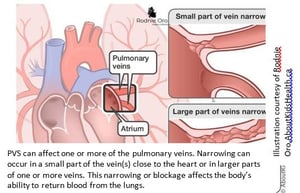What is pulmonary vein stenosis?
Pulmonary vein stenosis (PVS) is when veins are narrow or blocked.
- The pulmonary veins carry oxygen-rich blood from the lungs to the heart. This blood is then pumped out to the rest
of the body. This provides the oxygen it needs to function. - PVS can cause high pressure in the lungs. This causes the heart to work harder.
- When this happens for a long time, the heart won’t pump as well. This is called right heart failure.
What causes pulmonary vein stenosis?
PVS happens when there is a buildup of cells inside the walls of these pulmonary veins. This causes in a narrowing or blockage. The amount of blockage and number of veins affected can be different for every child. Sometimes only a small section of the vein is narrowed or blocked. In other cases, blockages may run the length of the vein. There is not a known genetic cause.
It is not known why the buildup of cells in the pulmonary veins happens. It is also unknown why it gets worse more quickly for some children.
There are two types of pulmonary vein stenosis:
- Primary PVS: is also called congenital pulmonary vein stenosis or idiopathic pulmonary vein stenosis. This happens when the pulmonary veins have not been repaired. It also happens in babies who are born very prematurely. It is not related to a cardiac procedure.
- Post-repair PVS: This happens after a procedure or surgery to fix the pulmonary veins. An example is total anomalous pulmonary venous return (TAPVR). Post-repair PVS is seen in about 1 out of 10 of patients who have had this procedure or surgery.
What are the symptoms of pulmonary vein stenosis?
PVS often goes overlooked and underdiagnosed. This is because the signs and symptoms can be seen in other conditions. Some are:
- Fast breathing.
- Very tired.
- Bleeding in the lungs.
- Frequent colds and pneumonia.
- Hard to gain weight and slow growth.
What tests might need to be done?
Tests to check blood flow in the pulmonary veins are:
- Echocardiogram.
- CT scan.
- Cardiac MRI.
- Cardiac Catheterization.
- Lung Perfusion scan.
Ask your child’s provider or nurse to learn more about these tests.
How is pulmonary vein stenosis treated?
There are three ways to treat PVS. Even after a treatment, there is a chance that PVS may return. It is important to follow up with your child’s doctor regularly.
1. Medicine treatments: There are no proven medical treatments for PVS. Different medicines may be used to manage PVS symptoms. This can include use of diuretics to help lessen fluid in the lungs. Your child may need medicines that are used
for pulmonary hypertension. After other treatments, medicines may be given to help lessen the narrowing that can re-occur.
2. Cardiac Catheterization Children may have a cardiac catheterization (or "heart cath") procedure. During the procedure, a heart doctor will put in a small balloon and inflate it. This is sometimes called a balloon angioplasty. In some cases, a small wire tube (stent) is put in to widen the vein. Both procedures help to increase blood flow through the veins.
Catheterizations are less invasive than surgery. It is common for the veins to narrow again. This means that a child with PVS may have to do this many times.
3. Surgery: Narrowed or blocked veins can be treated by a surgeon in the operating room. Surgical treatment can be done to open areas of narrowing of the pulmonary veins that are close to the heart. Opening this area helps improve blood flow through the pulmonary veins back to the heart.
Other resources that may be helpful:
• #1272 Echocardiogram teaching sheet
• Children’s Wisconsin webpage on Pulmonary Vein Stenosis




